YAMAHA XJ6-S 2012 Manual Online
Manufacturer: YAMAHA, Model Year: 2012, Model line: XJ6-S, Model: YAMAHA XJ6-S 2012Pages: 102, PDF Size: 2.68 MB
Page 81 of 102
![YAMAHA XJ6-S 2012 Manual Online PERIODIC MAINTENANCE AND ADJUSTMENT
6-35
6
is turned to “OFF”, then con-
nect the positive lead before
connecting the negative lead.
[ECA16840]
4. After installation, make sure that
the battery le YAMAHA XJ6-S 2012 Manual Online PERIODIC MAINTENANCE AND ADJUSTMENT
6-35
6
is turned to “OFF”, then con-
nect the positive lead before
connecting the negative lead.
[ECA16840]
4. After installation, make sure that
the battery le](/img/51/52609/w960_52609-80.png)
PERIODIC MAINTENANCE AND ADJUSTMENT
6-35
6
is turned to “OFF”, then con-
nect the positive lead before
connecting the negative lead.
[ECA16840]
4. After installation, make sure that
the battery leads are properly con-
nected to the battery terminals.NOTICE
ECA16530
Always keep the battery charged.
Storing a discharged battery can
cause permanent battery damage.
EAU52200
Replacing the fuses The main fuse and the fuse boxes are
located under the seat. (See page
3-18.)TIPTo access the main fuse, remove the
starter relay cover as shown.
The siren fuse and the patrol light fuse
are located behind the front cowling.
1. Starter relay cover
2. Main fuse
3. Spare main fuse
4. Fuse box
2
4
3
1
1. Taillight fuse
2. ABS control unit fuse
3. Police system fuse
4. ABS solenoid fuse
5. ABS motor fuse
6. Spare fuse
7. Headlight fuse
8. Ignition fuse
9. Signaling system fuse
10.Backup fuse (for clock and immobilizer sys-
tem)
11.Fuel injection system fuse
12.Radiator fan fuse
1
6 67
8
9
10
11
12
24
35
U1PWEAE0.book Page 35 Tuesday, February 7, 2012 4:21 PM
Page 82 of 102
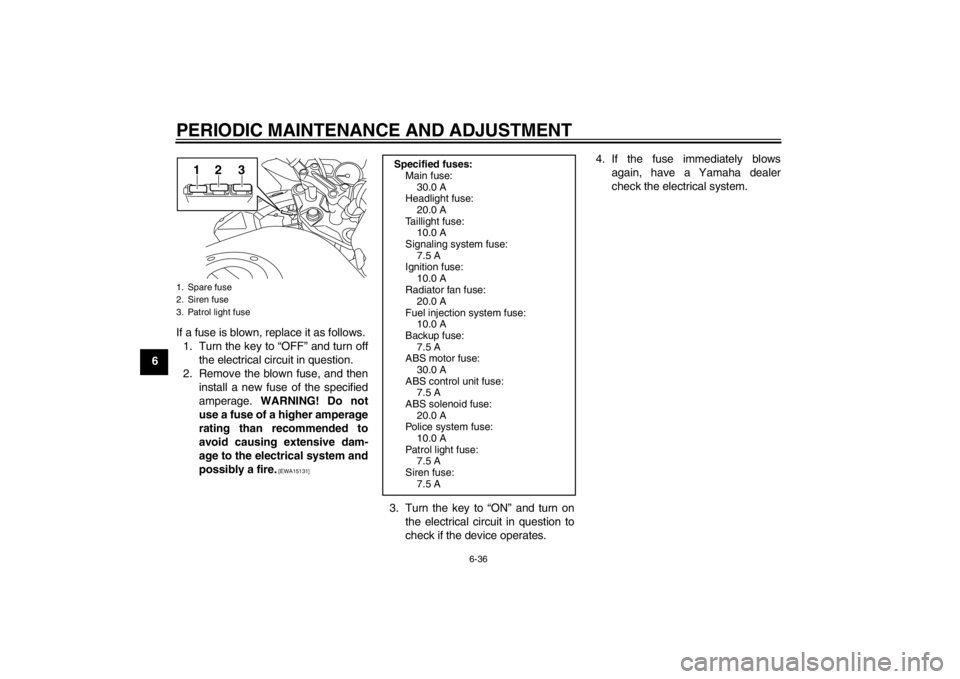
PERIODIC MAINTENANCE AND ADJUSTMENT
6-36
6If a fuse is blown, replace it as follows.
1. Turn the key to “OFF” and turn off the electrical circuit in question.
2. Remove the blown fuse, and then install a new fuse of the specified
amperage. WARNING! Do not
use a fuse of a higher amperage
rating than recommended to
avoid causing extensive dam-
age to the electrical system and
possibly a fire.
[EWA15131]
3. Turn the key to “ON” and turn on the electrical circuit in question to
check if the device operates. 4. If the fuse immediately blows
again, have a Yamaha dealer
check the electrical system.
1. Spare fuse
2. Siren fuse
3. Patrol light fuse
12 3
Specified fuses:Main fuse:
30.0 A
Headlight fuse:
20.0 A
Taillight fuse: 10.0 A
Signaling system fuse: 7.5 A
Ignition fuse:
10.0 A
Radiator fan fuse: 20.0 A
Fuel injection system fuse: 10.0 A
Backup fuse:
7.5 A
ABS motor fuse: 30.0 A
ABS control unit fuse: 7.5 A
ABS solenoid fuse:
20.0 A
Police system fuse: 10.0 A
Patrol light fuse: 7.5 A
Siren fuse:
7.5 A
U1PWEAE0.book Page 36 Tuesday, February 7, 2012 4:21 PM
Page 83 of 102
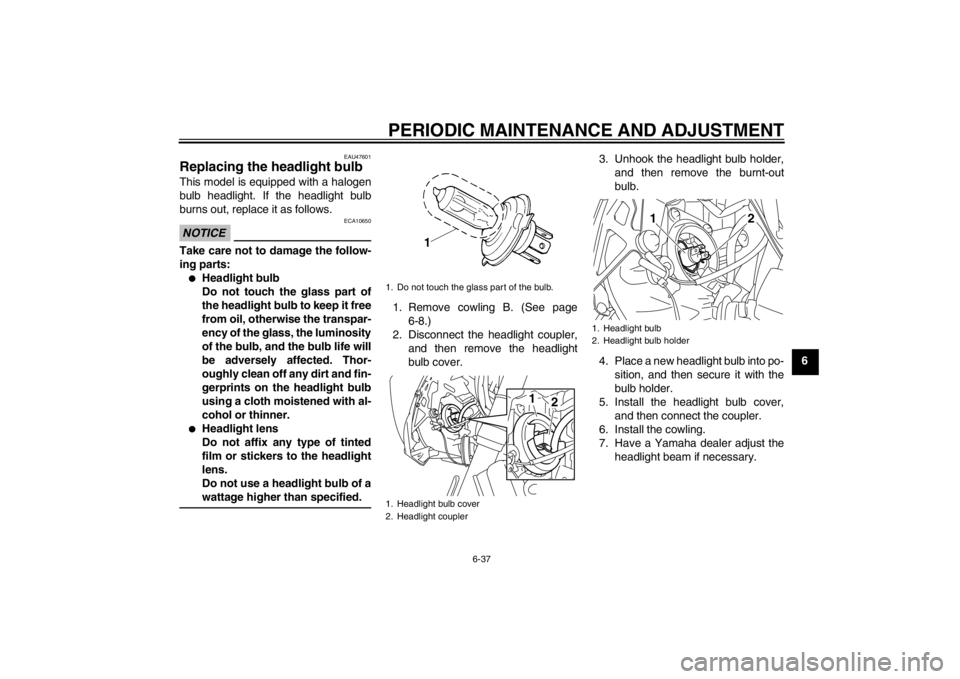
PERIODIC MAINTENANCE AND ADJUSTMENT
6-37
6
EAU47601
Replacing the headlight bulb This model is equipped with a halogen
bulb headlight. If the headlight bulb
burns out, replace it as follows.NOTICE
ECA10650
Take care not to damage the follow-
ing parts:●
Headlight bulb
Do not touch the glass part of
the headlight bulb to keep it free
from oil, otherwise the transpar-
ency of the glass, the luminosity
of the bulb, and the bulb life will
be adversely affected. Thor-
oughly clean off any dirt and fin-
gerprints on the headlight bulb
using a cloth moistened with al-
cohol or thinner.
●
Headlight lens
Do not affix any type of tinted
film or stickers to the headlight
lens.
Do not use a headlight bulb of a
wattage higher than specified.
1. Remove cowling B. (See page6-8.)
2. Disconnect the headlight coupler, and then remove the headlight
bulb cover. 3. Unhook the headlight bulb holder,
and then remove the burnt-out
bulb.
4. Place a new headlight bulb into po- sition, and then secure it with the
bulb holder.
5. Install the headlight bulb cover, and then connect the coupler.
6. Install the cowling.
7. Have a Yamaha dealer adjust the headlight beam if necessary.1. Do not touch the glass part of the bulb.
1. Headlight bulb cover
2. Headlight coupler
1 2
1. Headlight bulb
2. Headlight bulb holder
1
2
U1PWEAE0.book Page 37 Tuesday, February 7, 2012 4:21 PM
Page 84 of 102
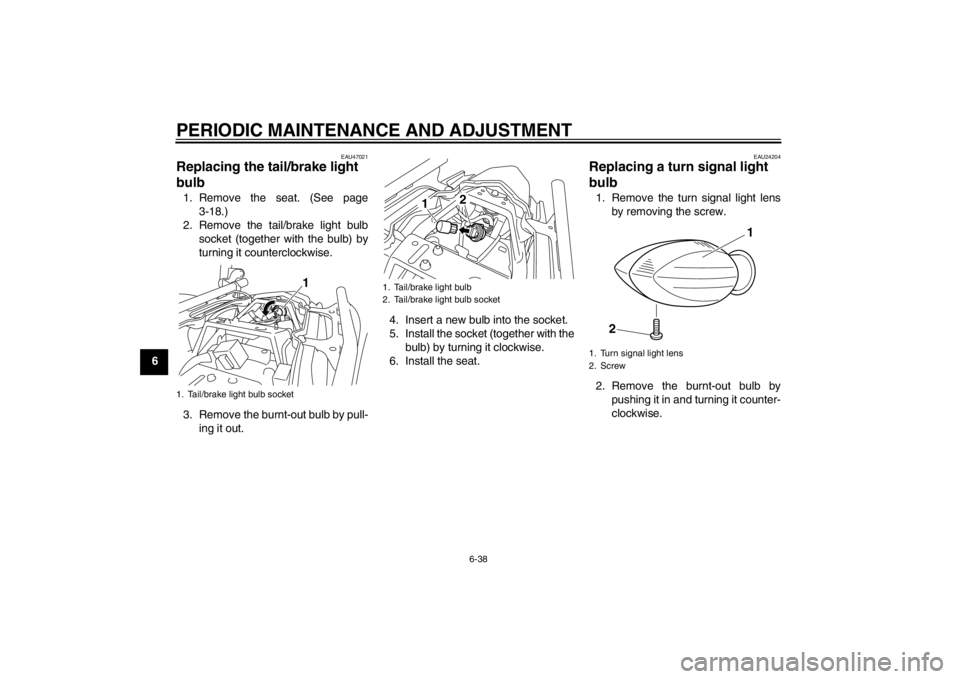
PERIODIC MAINTENANCE AND ADJUSTMENT
6-38
6
EAU47021
Replacing the tail/brake light
bulb 1. Remove the seat. (See page3-18.)
2. Remove the tail/brake light bulb socket (together with the bulb) by
turning it counterclockwise.
3. Remove the burnt-out bulb by pull- ing it out. 4. Insert a new bulb into the socket.
5. Install the socket (together with the
bulb) by turning it clockwise.
6. Install the seat.
EAU24204
Replacing a turn signal light
bulb 1. Remove the turn signal light lens by removing the screw.
2. Remove the burnt-out bulb by pushing it in and turning it counter-
clockwise.
1. Tail/brake light bulb socket
1
1. Tail/brake light bulb
2. Tail/brake light bulb socket
2
1
1. Turn signal light lens
2. Screw
1
2
U1PWEAE0.book Page 38 Tuesday, February 7, 2012 4:21 PM
Page 85 of 102
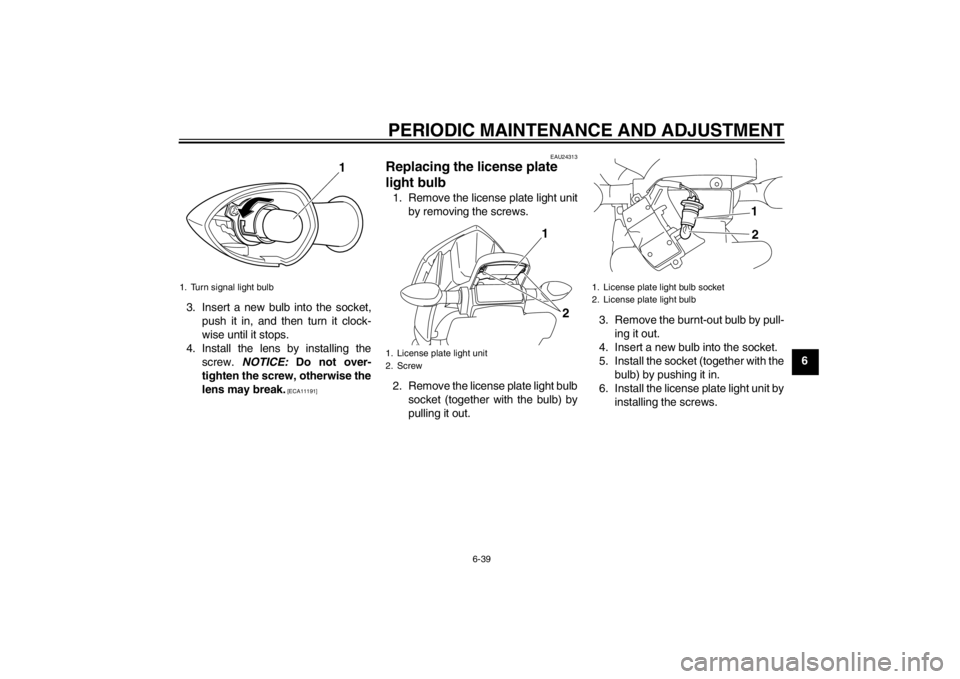
PERIODIC MAINTENANCE AND ADJUSTMENT
6-39
6
3. Insert a new bulb into the socket,
push it in, and then turn it clock-
wise until it stops.
4. Install the lens by installing the screw. NOTICE: Do not over-
tighten the screw, otherwise the
lens may break.
[ECA11191] EAU24313
Replacing the license plate
light bulb 1. Remove the license plate light unit
by removing the screws.
2. Remove the license plate light bulb socket (together with the bulb) by
pulling it out. 3. Remove the burnt-out bulb by pull-
ing it out.
4. Insert a new bulb into the socket.
5. Install the socket (together with the bulb) by pushing it in.
6. Install the license plate light unit by installing the screws.
1. Turn signal light bulb
1
1. License plate light unit
2. Screw
2
1
1. License plate light bulb socket
2. License plate light bulb
1
2
U1PWEAE0.book Page 39 Tuesday, February 7, 2012 4:21 PM
Page 86 of 102
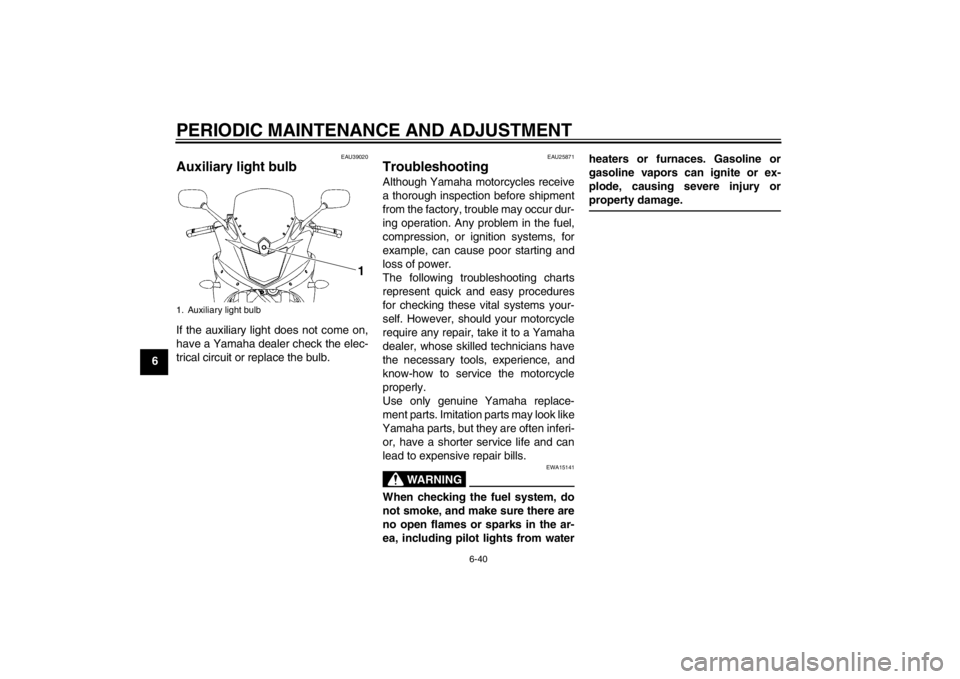
PERIODIC MAINTENANCE AND ADJUSTMENT
6-40
6
EAU39020
Auxiliary light bulb If the auxiliary light does not come on,
have a Yamaha dealer check the elec-
trical circuit or replace the bulb.
EAU25871
Troubleshooting Although Yamaha motorcycles receive
a thorough inspection before shipment
from the factory, trouble may occur dur-
ing operation. Any problem in the fuel,
compression, or ignition systems, for
example, can cause poor starting and
loss of power.
The following troubleshooting charts
represent quick and easy procedures
for checking these vital systems your-
self. However, should your motorcycle
require any repair, take it to a Yamaha
dealer, whose skilled technicians have
the necessary tools, experience, and
know-how to service the motorcycle
properly.
Use only genuine Yamaha replace-
ment parts. Imitation parts may look like
Yamaha parts, but they are often inferi- or, have a shorter service life and can
lead to expensive repair bills.
WARNING
EWA15141
When checking the fuel system, do
not smoke, and make sure there are
no open flames or sparks in the ar-
ea, including pilot lights from water heaters or furnaces. Gasoline or
gasoline vapors can ignite or ex-
plode, causing severe injury or
property damage.
1. Auxiliary light bulb
1
U1PWEAE0.book Page 40 Tuesday, February 7, 2012 4:21 PM
Page 87 of 102
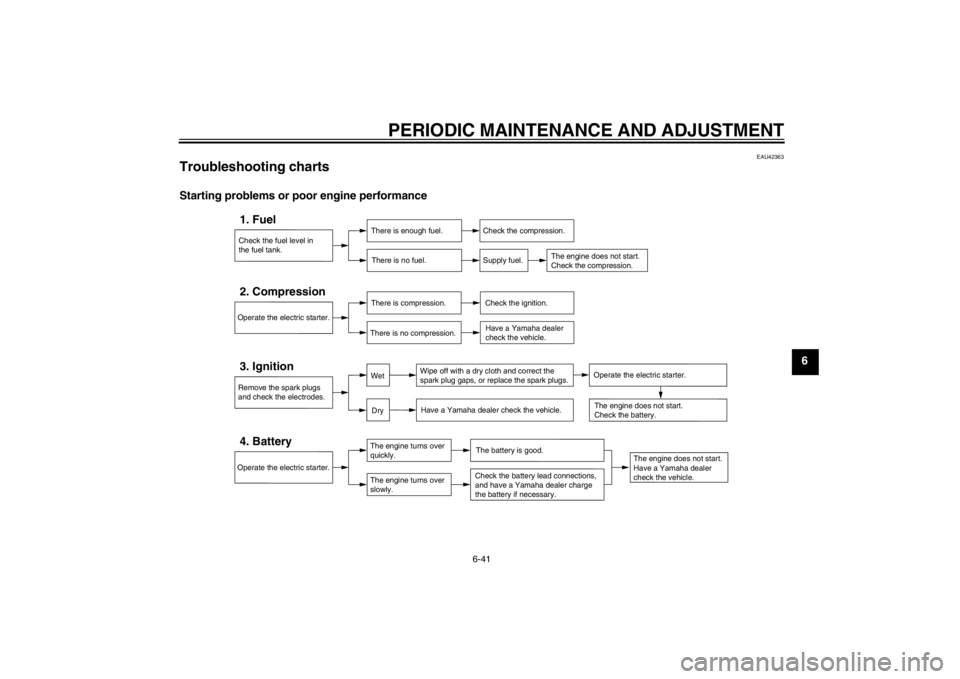
PERIODIC MAINTENANCE AND ADJUSTMENT
6-41
6
EAU42363
Troubleshooting charts Starting problems or poor engine performance
Check the fuel level in
the fuel tank.1. Fuel
There is enough fuel.There is no fuel.
Check the compression.
Supply fuel.
The engine does not start.
Check the compression.
Operate the electric starter.2. Compression
There is compression.
There is no compression.
Check the ignition. Have a Yamaha dealer
check the vehicle.
Remove the spark plugs
and check the electrodes.3. Ignition
Wipe off with a dry cloth and correct the
spark plug gaps, or replace the spark plugs.
Have a Yamaha dealer check the vehicle.
The engine does not start.
Have a Yamaha dealer
check the vehicle.
The engine does not start.
Check the battery.
Operate the electric starter.4. Battery
The engine turns over
quickly.
The engine turns over
slowly.
The battery is good.Check the battery lead connections,
and have a Yamaha dealer charge
the battery if necessary.
DryWet
Operate the electric starter.
U1PWEAE0.book Page 41 Tuesday, February 7, 2012 4:21 PM
Page 88 of 102
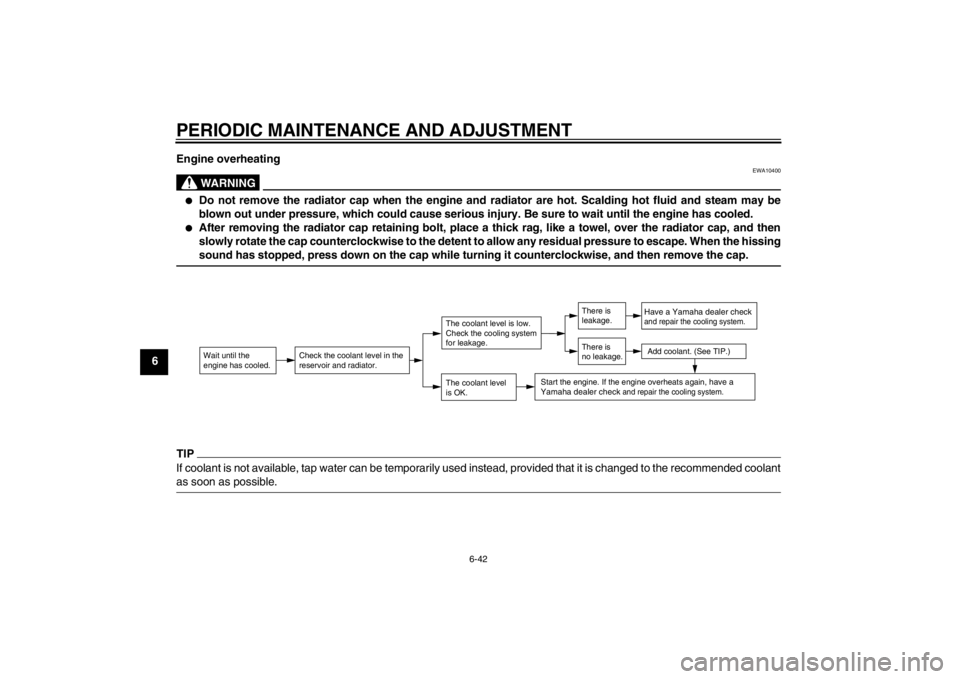
PERIODIC MAINTENANCE AND ADJUSTMENT
6-42
6Engine overheating
WARNING
EWA10400
●
Do not remove the radiator cap when the engine and
radiator are hot. Scalding hot fluid and steam may be
blown out under pressure, which could cause serious injury. Be sure to wait until the engine has cooled.
●
After removing the radiator cap retaining bolt, place a thick rag, like a towel, over the radiator cap, and then
slowly rotate the cap counterclockwise to the detent to allow any residual pressure to escape. When the hissing
sound has stopped, press down on the cap while turning it counterclockwise, and then remove the cap.
TIPIf coolant is not available, tap water can be temporarily used instead, provided that it is changed to the recommended coolant
as soon as possible.
Wait until the
engine has cooled.
Check the coolant level in the
reservoir and radiator.
The coolant level
is OK.The coolant level is low.
Check the cooling system
for leakage.
Have a Yamaha dealer checkand repair the cooling system.Add coolant. (See TIP.)
Start the engine. If the engine overheats again,
have a
Yamaha dealer check
and repair the cooling system.
There is
leakage.
There is
no leakage.
U1PWEAE0.book Page 42 Tuesday, February 7, 2012 4:21 PM
Page 89 of 102
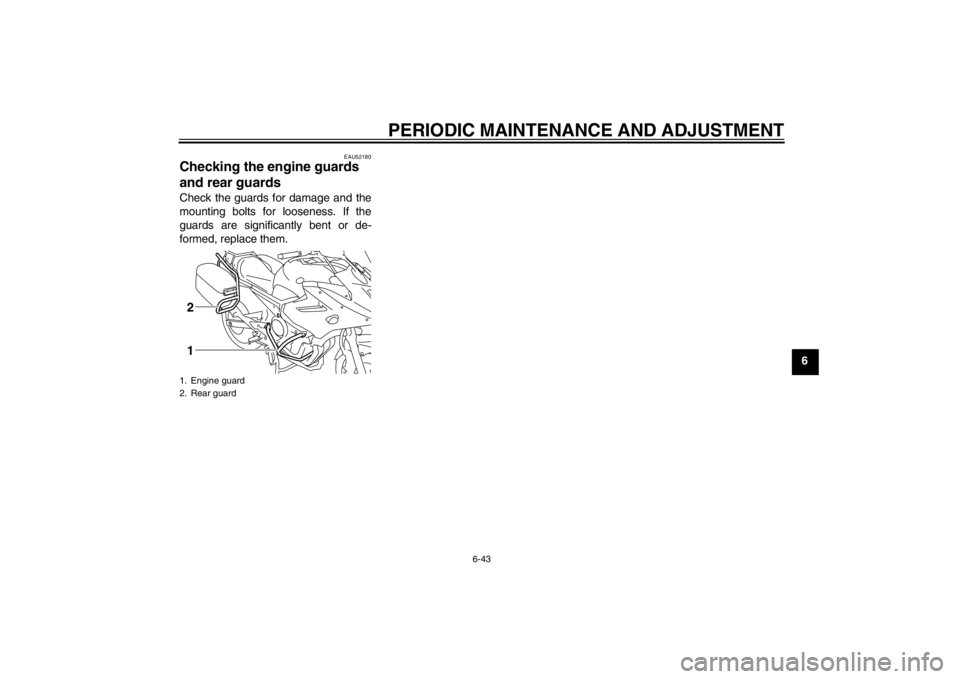
PERIODIC MAINTENANCE AND ADJUSTMENT
6-43
6
EAU52180
Checking the engine guards
and rear guards Check the guards for damage and the
mounting bolts for looseness. If the
guards are significantly bent or de-
formed, replace them.1. Engine guard
2. Rear guard21
U1PWEAE0.book Page 43 Tuesday, February 7, 2012 4:21 PM
Page 90 of 102
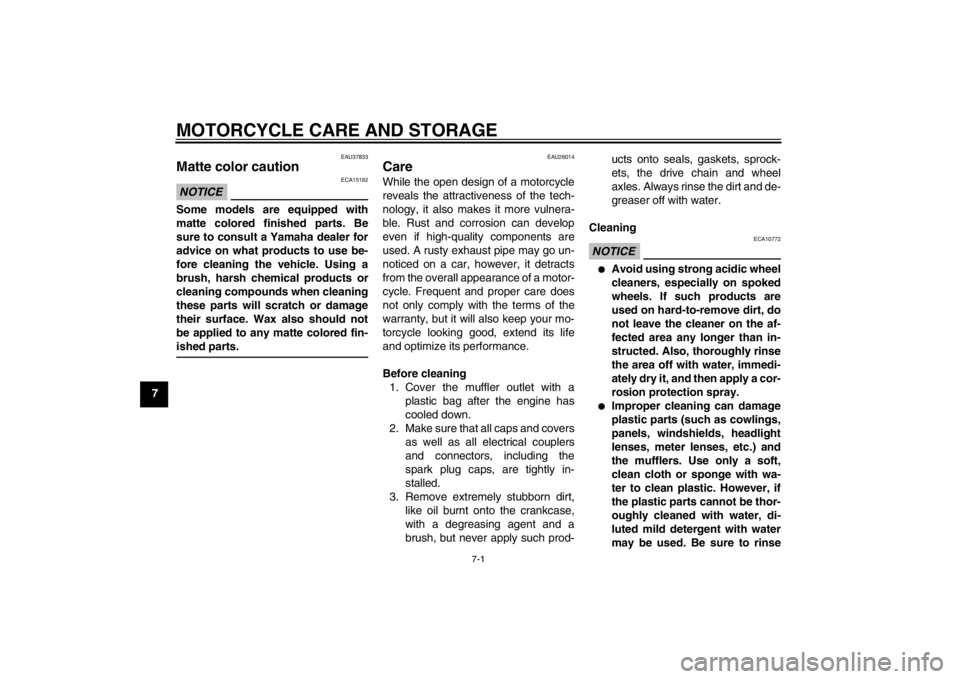
MOTORCYCLE CARE AND STORAGE
7-1
7
EAU37833
Matte color caution NOTICE
ECA15192
Some models are equipped with
matte colored finished parts. Be
sure to consult a Yamaha dealer for
advice on what products to use be-
fore cleaning the vehicle. Using a
brush, harsh chemical products or
cleaning compounds when cleaning
these parts will scratch or damage
their surface. Wax also should not
be applied to any matte colored fin-
ished parts.
EAU26014
Care While the open design of a motorcycle
reveals the attractiveness of the tech-
nology, it also makes it more vulnera-
ble. Rust and corrosion can develop
even if high-quality components are
used. A rusty exhaust pipe may go un-
noticed on a car, however, it detracts
from the overall appearance of a motor-
cycle. Frequent and proper care does
not only comply with the terms of the
warranty, but it will also keep your mo-
torcycle looking good, extend its life
and optimize its performance.
Before cleaning1. Cover the muffler outlet with a plastic bag after the engine has
cooled down.
2. Make sure that all caps and covers as well as all electrical couplers
and connectors, including the
spark plug caps, are tightly in-
stalled.
3. Remove extremely stubborn dirt, like oil burnt onto the crankcase,
with a degreasing agent and a
brush, but never apply such prod- ucts onto seals, gaskets, sprock-
ets, the drive chain and wheel
axles. Always rinse the dirt and de-
greaser off with water.
Cleaning
NOTICE
ECA10772
●
Avoid using strong acidic wheel
cleaners, especially on spoked
wheels. If such products are
used on hard-to-remove dirt, do
not leave the cleaner on the af-
fected area any longer than in-
structed. Also, thoroughly rinse
the area off with water, immedi-
ately dry it, and then apply a cor-
rosion protection spray.
●
Improper cleaning can damage
plastic parts (such as cowlings,
panels, windshields, headlight
lenses, meter lenses, etc.) and
the mufflers. Use only a soft,
clean cloth or sponge with wa-
ter to clean plastic. However, if
the plastic parts cannot be thor-
oughly cleaned with water, di-
luted mild detergent with water
may be used. Be sure to rinse
U1PWEAE0.book Page 1 Tuesda y, February 7, 2012 4:21 PM